1.Introduction
Urbanization theory points out that with the rapid expansion of cities, although the concentrated use of resources improves economic efficiency, it also brings about "diseconomies of scale" such as dense population and increasing environmental pressure. Tokyo is one of the most influential metropolises in the world. As the economic, cultural, and administrative center of Japan, Tokyo has grown into one of the world’s megacities and contains a population of 13.5 billion people [1] However, like many modern, fast-growing cities, Tokyo inevitably encounters some problems along the way of development. Like many rapidly growing modern cities, Tokyo faces challenges along its path of development. As the economic engine of Japan, the city’s long-term growth is vital. In recent years, the Tokyo government has adopted an ambitious growth strategy aimed at positioning the city as Asia’s leading global financial and economic center, competing with other world-class cities[2]. At the same time, Tokyo seeks to create an inclusive society where "no one is left behind" while making its development more sustainable. Achieving these goals requires comprehensive and strategic planning across all aspects of the city’s growth[3].
As the capital of Japan, the world's third-largest economy, Tokyo faces challenges typical of Asian megacities. Despite its large population, Tokyo's relatively small land area (only 847 square miles) and its unique geographical location make it distinctive. This paper selects Tokyo as the primary case study to explore the city's developmental issues since 1950. The research will focus on the challenges Tokyo has encountered, such as population concentration, land resource shortages, agricultural and arable land problems, waste management, and natural disaster preparedness. Additionally, the paper will analyze existing solutions to these challenges from the perspective of urban planning and policy making, offering potential improvements based on Tokyo's current conditions.
2.Challenges in Urban Development in Japan
2.1.The significance of urban planning
Urbanization is a major 21st-century trend, with 68% of the global population projected to live in cities by 2050, especially in Asia and Africa. Over more than a century, societies have shifted from predominantly rural to predominantly urban[4]. Urban planning, a complex process, designs and manages cities to create sustainable, functional, and equitable environments. It balances economic growth, environmental protection, and social equity, addressing land use, transportation, housing, and infrastructure. Planners navigate political challenges, develop zoning laws, manage resources, and alleviate issues like congestion and environmental degradation [5].
Therefore, planners need to adapt to emerging trends such as climate change, technological innovation and the shift to smart cities. The planning of large cities requires planners to work closely with stakeholders to create cities that are not only economically competitive but also inclusive and resilient in the face of future challenges.
2.2.Analysis of Tokyo's Land Shortage and Population Problems
As one of the most attractive cities globally, Tokyo has experienced rapid population growth and urban expansion. Japan’s population distribution is highly variable. The mountainous character of the country has caused the population to concentrate within the limited plains and lowlands—notably along the Pacific littoral [6]. Together with the will of seeking jobs and opportunities, this keeps the population in Tokyo increasing, concentrating a large amount of population in limited area. Before the Covid pandemic, the number of people moving into Tokyo out numbered those leaving the city by up to 80,000 each year[7]. As being one of the most urbanized, productive, and populous cities, Tokyo’s population grows rapidly with its development. Nevertheless, this led to some serious problems, among which the shortage of land resources becomes one of the most prominent.
According to the urban structure model, the population density of Tokyo is highest in the central area, while the surrounding area is gradually sparse. However, with the continuous expansion of the city, this structure is gradually breaking down, and the land resources in the city center are increasingly strained. Based on the central place theory, the center of Tokyo concentrates the most employment opportunities and service facilities, attracting a large influx of people. From a supply and demand perspective, this influx leads to a shortage of land and rising property prices. This not only drives up the cost of living but also results in the conversion of farmland and green spaces into residential and commercial developments, further intensifying the issue of land scarcity.
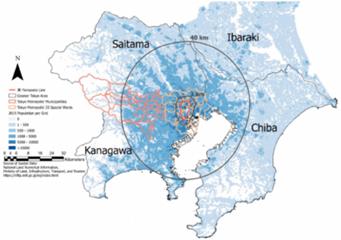
Figure 1: Population Density Map of Tokyo Metropolis' 23 Special Wards, Tama Area, and Neighboring Prefectures (2015) [8]
In Figure 1 Burgess was used to describe the distribution of population and land use. As illustrated in Figure 1, Tokyo, as a major metropolis with an extensive rail transit network, benefits from highly convenient transportation. Additionally, its proximity to the sea further facilitates the movement of people within the city, contributing to a continued increase in population density.
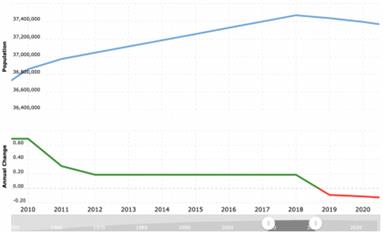
Figure 2: Population change in Tokyo from 2010 to 2020 [9].
Shown in Figure 2, the line chart clearly shows the huge increase in the population of Tokyo between 2010 and 2020. Although the annual change of increasing in population keeps reducing, the total population has still increased by more than one million [9]. In the case of no change in urban area, the population density of Tokyo has obviously increased a lot, which fully proves the increasingly serious shortage of land resources. In fact, over time, the problem could become so severe that it could lead to devastating results. Insufficient land resources will lead to smaller farmland, low production person and increasing landlessness [10]. Similarly, the per capita land area in the society decreases, and people's quality of life is also not guaranteed, which helps to increase poverty. Therefore, this problem needs to be effectively addressed or mitigated.
2.3.Analysis of Agricultural Development Issues
According to the theory of sustainable development, stable agricultural land is an important basis for ensuring food and food safety. Locally produced agricultural and livestock products can meet people's demand for fresh and secure food, which is inseparable from the hard-working farmer group. Farmland is also an essential element in cities. Besides producing food, it can also function as disaster prevention and excavation site. It plays important role in citizens’ life. Generally, the positive effect on the whole society which attributes to its agriculture is enormous.
However, with urban expansion, land use patterns have changed significantly, and farmland has been continuously converted into residential and commercial land, resulting in a decrease in agricultural land area. Land use and farmland loss theory points out that this trend is particularly pronounced in Tokyo, where the high price of land induces farmers to sell land for non-agricultural development. In addition, the aging society theory also suggests that the agricultural population in the area around Tokyo is gradually aging, and young people are less interested in agriculture, further weakening the sustainability of agricultural production.
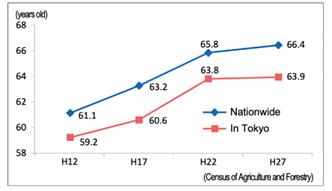
Figure 3: Trends in the average age of farmers[11].
In 2015, the average age of farmers in Tokyo has reached 63.9 years old, which is 3.3 years higher than that of the one ten years before[11]. As shown in Figure 3, according to the census results in recent years, the average age of farmers in both Tokyo and the whole Japan has increased significantly, and still showing a upward trend. The increase in the average age of farmers will lead to the decline in overall productivity and efficiency. Ensuring the quality and quantity of agricultural products in Tokyo poses significant challenges, potentially leading to higher crop prices. This increase in costs adversely affects residents, who must purchase locally grown produce at elevated prices. Additionally, crops transported from other regions face issues such as extended storage times, which can compromise freshness and fail to meet the demand for healthy food options. To address these challenges, it is crucial to sustain agricultural vitality and stabilize the food supply through supportive government policies and social initiatives. For older farmers, selling their land could be a viable solution to address these issues.
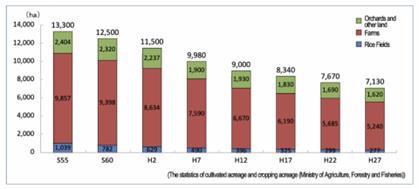
Figure 4: Trends in area of farmland[11].
In addition to the aging of farmers, Tokyo is also facing a decline in farmland. Due to urbanization and inheritance, the amount of available agricultural land in Tokyo decreases yearly. In the decade started by 2005, agricultural land in Tokyo has decreased by 1,210 ha, with a decrease by 14.5%. Nearly 993.6 ha of agricultural land has been lost within urbanization promotion areas in the decade. Meanwhile, Because of the housing shortage caused by population agglomeration, part of the farmland has been repurposed for residential use[11]. However, this phenomenon should not be encouraged, because it will lead to more lack of agricultural land, which will lead to higher prices of agricultural land and agricultural products , at the same time impairing various functions of the agricultural land. Consequently, it is reasonable that the city's farmland needs the intervention of urban planning. This would allow agriculture in tokyo to be carried out in a more efficient manner. Only in this way can the agricultural needs of Tokyo residents be met, making agricultural products more affordable and improving the living standards of residents in various ways.
2.4.Analysis of Tokyo's Waste Disposal Problems
Tokyo's waste disposal issue significantly impacts urban development. In densely populated cities, effective waste management is crucial for public health and overall quality of life. The cleanliness of large cities often reflects a nation's strength, making Japan's waste management practices particularly noteworthy. Indeed, the economic growth and industrialization of the 20th century led to a dramatic increase in waste production, presenting a substantial challenge for Tokyo's waste management system.
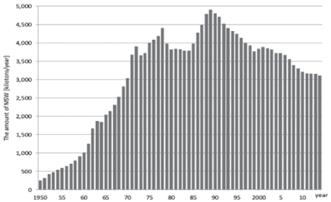
Figure 5: Changes of the amount of municipal solid waste in Tokyo from 1950 to 2010 [12]
As the twentieth century began, 35 million tons of waste was increased in 20 years. As shown in Figure 5, at the beginning of 1950s, the amount of municipal solid waste in Tokyo was just below 500 kilotons per year. In the following 40 years, this number kept climbing to nearly 5000 kilotons per year. In just a few decades, the number of MSWS produced annually in Tokyo had increased tenfold. Although Figure 5 declined slowly over the next two decades, Tokyo still produces more than 3000 kilotons MSW a year these days. This Figure 5 is a big burden for the city's waste disposal system.Meanwhile, a wide range of waste is generated daily, including construction and manufacturing waste. Among these, factory-produced waste contributes significantly to pollution and poses serious risks to public health. The urban setting is also a significant waste contributor. The 23 wards of Tokyo generate around 3 million tonnes of municipal solid waste each year, around 70% of waste comes from households, while the other 30% comes from the business sector [13].
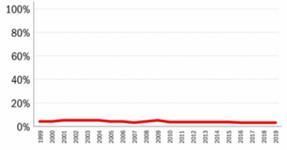
Figure 6: Food sufficiency rate of Tokyo from 1999 to 2019 [14]
Besides the municipal solid waste, food waste is also a large source of waste. Although in Japan's traditional culture, it is a custom to respect farmers' labor and food, in reality, 1.3 billion of edible food is wasted annually. In Tokyo, industrial food waste from restaurants totals around 980,000 tons annually, while households contribute an additional 990,000 tons. While Japan's overall food sufficiency rate is nearly 66%, this figure drops to just 3% in Tokyo, as shown in Figure 6. This discrepancy arises from the city’s reliance on food imports from nearby areas, much of which is wasted rather than consumed[15].Even though Tokyo has one of the world's most advanced waste sorting systems and a pleasing level of public awareness, its centralized waste disposal and recycling efficiency is not that high. With only one operating landfill, waste disposal can be said as inefficient in Tokyo. Furthermore, this landfill will meet its capacity in about 50 years. Consequently, finding alternative solutions for municipal waste disposal is becoming increasingly urgent. Adopting strategies that promote a circular economy is essential for addressing these challenges.
The circular economy theory provides a solution approach, that is, reducing waste generation and landfill pressure through resource recovery and reuse. Tokyo has begun to implement strict waste sorting and resource recovery policies to vigorously promote the recycling of waste, however, in the face of such a large amount of waste production, there is still a need to further improve efficiency. At the same time, public goods theory points out that waste disposal is not only the responsibility of individuals, but also the responsibility of the whole society. The Tokyo Metropolitan government strives to raise environmental awareness among residents by educating the public, formulating regulations, and imposing penalties, and plays an important role in the construction and operation of waste disposal facilities. However, a thorough solution to the waste problem will require broader social cooperation and continued technological innovation.
2.5.Analysis of Earthquake Disaster Issues
As an island nation located in the earthquake zone, also on a fault line, Japan is a hotspot for earthquake activity, and Tokyo is not an exception. Strong earthquakes and tsunamis are common in Tokyo. There is a great potential for the loss of residents' lives and property.

Figure 7: Earthquake directly beneath the Tokyo of M>6.0 in the period 1615-1922 [12]
Figure 7 shows the recorded major earthquake happened directly beneath Tokyo cities in recent hundreds of years. This table is enough to show the frequency of earthquakes in Tokyo, with more than 20 earthquakes happened in about three hundred years.Tokyo is situated in a seismically active region, experiencing frequent natural disasters. Effectively managing these threats is a crucial issue for urban planning. Disaster management theory stresses the necessity for cities to develop a comprehensive disaster prevention system. This system should encompass everything from seismic design of buildings to effective emergency response strategies following disasters.
3.Solutions to Tokyo's Urban Problems
3.1.Optimizing Population Distribution in Tokyo
By facilitating more effective population distribution, it can prevent excessive concentration in Tokyo’s limited space, thereby enhancing overall allocation efficiency and supporting the city in achieving its development objectives. To tackle the problem of high population density, various ideas and plans have been proposed. The paper "Urban Land Use and Population Density in Tokyo" discusses the relationship between land use and population density in detail and points out that reasonable land planning can effectively alleviate the pressure brought by excessive population concentration. Population Distribution and Housing Policies in Tokyo analyzes the impact of different housing policies on population distribution and suggests that reasonable population distribution can be promoted by optimizing housing distribution. Challenges of Urbanization in Tokyo and Sustainable Urban Development in Tokyo propose long-term solutions to population problems from the perspectives of challenges brought by urbanization and sustainable development strategies, respectively.
In fact, the Tokyo government has already implemented many programs to solve this problem. Started from 2019, the Tokyo government started paying residents to leave to area outside of Tokyo. Individuals who have lived and worked in Tokyo for at least five years are eligible to receive 600,000 yen (approximately $4,500) if they move to rural areas. For couples, the incentive is increased to 1 million yen (about $7,700) [7]. In addition, there’s support of the construction of "Tokyo version CCRC (continuing care retirement community)" (welfare policies), which is a kind of hotel that, instead of having fewer, larger rooms, has more, smaller rooms, that still supply basic needs. This allows for more people to have suitable accommodation.
3.2.Addressing Agricultural Challenges in Tokyo
In terms of Tokyo's agricultural development, since agriculture in Tokyo is under the dual pressure of a decrease in the number of farmers and an increase in the price of agricultural land, many discussions are already under way to mitigate this problem. "The Decline of Agriculture in Tokyo's Urban Areas" and "Farmland Prices and Urbanization in Tokyo" discuss the trend of decreasing number of farmers and its impact on agricultural production, respectively. And the impact of higher farmland prices on food prices. Urban Agriculture: A Solution to Food Security in Tokyo presents urban agriculture as a potential solution to food security problems, Policies to Support Urban Farmers in Tokyo, on the other hand, examines the government's policy measures in supporting urban farmers and their effectiveness. Beyond theory, the Tokyo government has actually taken some action. The Tokyo Metropolitan Government, in order to maintain urban agriculture in the future, has requested the national government to revise the laws, regulations, and taxation system involving urban agriculture and farmland. For instance, the Ministry of Agriculture, Forestry and Fisheries organized a Study Group for Promoting Urban Agriculture. At the same time, the Basic Act on the Promotion of Urban Agriculture which defines the guiding principle of the promotion of urban agriculture, was enacted in April 2015, aiming to stably sustain urban agriculture and create a favorable urban environment through the various functions of urban agriculture. In addition, at present, Tokyo Development Foundation for Agriculture, Forestry and Fisheries (Public Interest Incorporated Foundation) work on training agriculture support volunteers in association with municipalities. There were 2,180 registered supporters of agriculture in Tokyo at the end of fiscal 2015.
3.3.Evolving Policies and Innovations in Tokyo's Waste Management
In terms of waste disposal, many policies have been developed and implemented to mitigate this problem. “Waste Cleaning Act” was the first policy established. It stated that waste should be incinerated if possible. However, since the incineration facilities were not generally available, waste were piled up out in the open and continuously burned with more materials all the time, which actually contributed more to the air pollution[15]. Beginning in 1900, policies focusing on public health improvement, pollution problems and living environment protection and establishment of a sound material-cycle society have been implemented gradually. Resident started to follow the obligation of cooperating with municipalities in collecting and disposing of waste. In recent years, goals for resource productivity are intended to increase from 37 to 49 from 2010 to 2025. Rules for sorting waste has also been established, with the process of waste collection (combustible waste, non-combustible waste, and plastics and rubber scrap.
for example) being given out. This greatly improves the efficiency of waste recycling and utilization.
Companies play a crucial role in waste recycling, exemplified by the Taisei Corporation. As a leading construction and engineering firm, Taisei has implemented an innovative waste management system across Tokyo. This system includes a vacuum waste collection method that transports waste through underground pipes to city collection facilities. This approach is time-efficient and reduces the need for garbage trucks, thereby minimizing traffic congestion and carbon emissions in Tokyo. Public awareness and community involvement are also key to Tokyo's waste management success. Street cleaners, local managers, and even ordinary citizens contribute to maintaining cleanliness by picking up litter and keeping their neighborhoods tidy. Technological advancements have significantly improved waste management as well. New equipment for transporting waste, both domestically and internationally, has been developed, including lighter garbage collection trucks that increase load capacity and efficiency. Additionally, PET bottles are now sorted and recycled into new bottles or carpets, thanks to the Act on the Promotion of Sorted Collection and Recycling of Containers and Packaging and advancements in recycling technology [16].
3.4.Enhancing Disaster Resilience in Tokyo
Tokyo has accumulated a wealth of experience in dealing with natural disasters such as earthquakes and typhoons. From the perspectives of Earthquake Resilience in Tokyo's Building Structures and Typhoon Mitigation Strategies in Tokyo, the latest progress in improving disaster prevention capabilities in Tokyo is analyzed. Frequency and Impact of Natural Disasters in Tokyo explores the frequency of natural disasters and their impact on the city, pointing out that effective disaster management strategies are essential to reduce disaster losses. Urban Planning for Disaster Risk Reduction in Tokyo studies how Tokyo integrates disaster risk management in urban planning and proposes a series of strategies and measures for disaster risk reduction.
Tokyo’s building codes require all new buildings to meet strict earthquake resistance standards, which has significantly reduced building damage and casualties from earthquakes. In fact, Tokyo also does its best to make its buildings resilient to earthquakes. One of its methods it called “seismic isolation”. This method requires installing isolators and energy absorbing devices under the superstructure [17].This isolator not only provides structural safety, but also help to prevent the potential danger on people and their properties in the building. Also, urban resilience theory highlights that Tokyo's disaster response system, which includes regular drills and active community participation, has enhanced residents' ability to cope with and quickly recover from disasters. Risk management theory further underscores that Tokyo's advanced earthquake early warning system and thorough risk assessments enable the city to implement preventive measures, mitigating the impact of earthquakes. These strategies have not only strengthened Tokyo's disaster preparedness but also offer valuable insights for other earthquake-prone regions. In the context of earthquake preparedness, urban planning must address not only building standards but also public awareness and post-earthquake recovery efforts. For a city like Tokyo, which is highly vulnerable to earthquakes, it is crucial for residents to be well-informed and prepared both before and after a disaster.
4.Conclusion
In conclusion, Tokyo, a leading global metropolis, epitomizes both the opportunities and challenges of rapid urbanization. The city faces significant issues, including land shortages, declining agricultural areas, waste management difficulties, and disaster preparedness concerns, all of which reflect broader challenges faced by megacities worldwide. As Tokyo continues to expand, it grapples with obstacles that threaten its sustainability and residents' quality of life. To address these issues, a multifaceted approach is essential, involving strategic planning, innovative solutions, and collaborative efforts. Tackling these challenges effectively will not only enhance Tokyo’s resilience but also set a benchmark for other global cities encountering similar urbanization problems.
However, this study has limitations. Data availability and reliability on Tokyo's urban issues can be inconsistent, and the diverse impacts of policies might be challenging to measure accurately. Additionally, the focus on Tokyo may not fully capture the unique challenges faced by other megacities. Future research should explore comparative studies with other global cities to identify universal and unique urbanization challenges. Investigating the long-term impacts of specific policies and innovative practices on sustainability, quality of life, and resilience in Tokyo and similar cities could provide deeper insights and practical solutions for urban development.
References
[1]. Statista. "Topic: Tokyo." Statista. Retrieved June 29, 2024, from https://www.statista.com/topics/9914/tokyo/.
[2]. Tokyo Metropolitan Government. (2017). Tokyo drives the Japanese economy. Retrieved August 1, 2024, from https://www.metro.tokyo.lg.jp/ENGLISH/GOVERNOR/SPEECHES/2017/0222/contents06.htm.
[3]. Tokyo Metropolitan Government. (2024). Future Tokyo: Tokyo's long-term strategy and the SDGs. Retrieved August 1, 2024, from https://www.sdgs.metro.tokyo.lg.jp/en/about-sdgs/future-tokyo-sdgs/.
[4]. Tonne, C., Adair, L., Adlakha, D., Anguelovski, I., Belesova, K., Berger, M., ... & Adli, M. (2021). Defining pathways to healthy sustainable urban development. Environment International, 146, 106236.
[5]. Levy, J. M., Hirt, S., & Dawkins, C. J. (2009). Contemporary urban planning. Upper Saddle River, NJ: Pearson/Prentice Hall.
[6]. Vogt, G. (2018). Population aging and international health-caregiver migration to Japan. New York: Springer International Publishing.
[7]. Yeung, E., & Jozuka, J. (2023, January 4). Tokyo is so crowded the government is paying families to leave. CNN Business. Retrieved from https://www.cnn.com/2023/01/04/business/japan-pay-families-relocate-tokyo-intl-hnk/index.html.
[8]. Leyso, N., & Umezaki, M. (2023). Uncovering spatial patterns and temporal trends in the aging of the Tokyo metropolis population. Journal of Population Ageing, 16(4), 939–958. Retrieved from https://doi.org/10.1007/s12062-023-09412-x.
[9]. Macrotrends. (n.d.). Tokyo, Japan metro area population 1950-2024. Retrieved August 1, 2024, from https://www.macrotrends.net/global-metrics/cities/21671/tokyo/population.
[10]. Food and Agriculture Organization. (n.d.). The problem of land degradation. Retrieved July 22, 2024, from https://www.fao.org/4/v9909e/v9909e02.htm.
[11]. Tokyo Metropolitan Government. (2017). Tokyo agriculture promotion plan: Chapter 1 - Tokyo agriculture reaches a turning point. Retrieved from https://www.sangyo-rodo.metro.tokyo.lg.jp/plan/nourin/%28Chapter1%20%20Tokyo%20Agriculture%20Reaches%20a%20Turning%20Point%29.pdf.
[12]. Rikitake, T. (1991). Assessment of earthquake hazard in the Tokyo area, Japan. Tectonophysics, 199(1), 121–131.
[13]. Luk, K. (2021, September 13). How strict waste management in Japan alleviated its environmental impact. Earth.Org. Retrieved from https://earth.org/japan-waste-management/.
[14]. What Design Can Do. (2017). No waste: Tokyo's approach. Retrieved from https://nowaste.whatdesigncando.com/app/uploads/2021/01/WDCD_NWC_Tokyo-Perspective_EN.pdf.
[15]. Ministry of the Environment, Japan. (2014). Japan’s national environmental plans. Retrieved from https://www.env.go.jp/content/900453392.pdf.
[16]. Lee, Y., Park, S., Kim, D., & Seo, J. (2024). Development of PET bottle to bottle recycle in Japan. Korean Journal of Packaging Science & Technology, 30(1), 31-42.
[17]. Nakamura, Y., & Okada, K. (2019). Review on seismic isolation and response control methods of buildings in Japan. Geoenvironmental Disasters, 6(1), 7. Retrieved from https://doi.org/10.1186/s40677-019-0123-y.
Cite this article
Wu,S. (2024). Navigating the Challenges of Urbanization: A Case Study of Tokyo’s Developmental Issues and Strategic Solutions. Communications in Humanities Research,48,65-74.
Data availability
The datasets used and/or analyzed during the current study will be available from the authors upon reasonable request.
Disclaimer/Publisher's Note
The statements, opinions and data contained in all publications are solely those of the individual author(s) and contributor(s) and not of EWA Publishing and/or the editor(s). EWA Publishing and/or the editor(s) disclaim responsibility for any injury to people or property resulting from any ideas, methods, instructions or products referred to in the content.
About volume
Volume title: Proceedings of the 3rd International Conference on Art, Design and Social Sciences
© 2024 by the author(s). Licensee EWA Publishing, Oxford, UK. This article is an open access article distributed under the terms and
conditions of the Creative Commons Attribution (CC BY) license. Authors who
publish this series agree to the following terms:
1. Authors retain copyright and grant the series right of first publication with the work simultaneously licensed under a Creative Commons
Attribution License that allows others to share the work with an acknowledgment of the work's authorship and initial publication in this
series.
2. Authors are able to enter into separate, additional contractual arrangements for the non-exclusive distribution of the series's published
version of the work (e.g., post it to an institutional repository or publish it in a book), with an acknowledgment of its initial
publication in this series.
3. Authors are permitted and encouraged to post their work online (e.g., in institutional repositories or on their website) prior to and
during the submission process, as it can lead to productive exchanges, as well as earlier and greater citation of published work (See
Open access policy for details).
References
[1]. Statista. "Topic: Tokyo." Statista. Retrieved June 29, 2024, from https://www.statista.com/topics/9914/tokyo/.
[2]. Tokyo Metropolitan Government. (2017). Tokyo drives the Japanese economy. Retrieved August 1, 2024, from https://www.metro.tokyo.lg.jp/ENGLISH/GOVERNOR/SPEECHES/2017/0222/contents06.htm.
[3]. Tokyo Metropolitan Government. (2024). Future Tokyo: Tokyo's long-term strategy and the SDGs. Retrieved August 1, 2024, from https://www.sdgs.metro.tokyo.lg.jp/en/about-sdgs/future-tokyo-sdgs/.
[4]. Tonne, C., Adair, L., Adlakha, D., Anguelovski, I., Belesova, K., Berger, M., ... & Adli, M. (2021). Defining pathways to healthy sustainable urban development. Environment International, 146, 106236.
[5]. Levy, J. M., Hirt, S., & Dawkins, C. J. (2009). Contemporary urban planning. Upper Saddle River, NJ: Pearson/Prentice Hall.
[6]. Vogt, G. (2018). Population aging and international health-caregiver migration to Japan. New York: Springer International Publishing.
[7]. Yeung, E., & Jozuka, J. (2023, January 4). Tokyo is so crowded the government is paying families to leave. CNN Business. Retrieved from https://www.cnn.com/2023/01/04/business/japan-pay-families-relocate-tokyo-intl-hnk/index.html.
[8]. Leyso, N., & Umezaki, M. (2023). Uncovering spatial patterns and temporal trends in the aging of the Tokyo metropolis population. Journal of Population Ageing, 16(4), 939–958. Retrieved from https://doi.org/10.1007/s12062-023-09412-x.
[9]. Macrotrends. (n.d.). Tokyo, Japan metro area population 1950-2024. Retrieved August 1, 2024, from https://www.macrotrends.net/global-metrics/cities/21671/tokyo/population.
[10]. Food and Agriculture Organization. (n.d.). The problem of land degradation. Retrieved July 22, 2024, from https://www.fao.org/4/v9909e/v9909e02.htm.
[11]. Tokyo Metropolitan Government. (2017). Tokyo agriculture promotion plan: Chapter 1 - Tokyo agriculture reaches a turning point. Retrieved from https://www.sangyo-rodo.metro.tokyo.lg.jp/plan/nourin/%28Chapter1%20%20Tokyo%20Agriculture%20Reaches%20a%20Turning%20Point%29.pdf.
[12]. Rikitake, T. (1991). Assessment of earthquake hazard in the Tokyo area, Japan. Tectonophysics, 199(1), 121–131.
[13]. Luk, K. (2021, September 13). How strict waste management in Japan alleviated its environmental impact. Earth.Org. Retrieved from https://earth.org/japan-waste-management/.
[14]. What Design Can Do. (2017). No waste: Tokyo's approach. Retrieved from https://nowaste.whatdesigncando.com/app/uploads/2021/01/WDCD_NWC_Tokyo-Perspective_EN.pdf.
[15]. Ministry of the Environment, Japan. (2014). Japan’s national environmental plans. Retrieved from https://www.env.go.jp/content/900453392.pdf.
[16]. Lee, Y., Park, S., Kim, D., & Seo, J. (2024). Development of PET bottle to bottle recycle in Japan. Korean Journal of Packaging Science & Technology, 30(1), 31-42.
[17]. Nakamura, Y., & Okada, K. (2019). Review on seismic isolation and response control methods of buildings in Japan. Geoenvironmental Disasters, 6(1), 7. Retrieved from https://doi.org/10.1186/s40677-019-0123-y.









